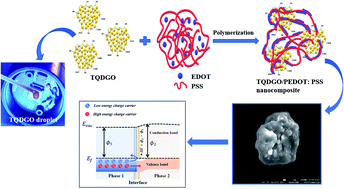Synthesis of quantum dot-based polymer nanocomposites: assessment of their thermoelectric performances†
Abstract
The polymer poly(3,4-ethylene dioxythiophene):polystyrene sulfonate (PEDOT:PSS) has been extensively studied due to its excellent electrical conductivity. However, until now, there have only been a few studies on quantum dot embedded polymers for thermoelectric (TE) applications. The current study describes a novel method for improving the TE properties of the polymer PEDOT:PSS by using titanium dioxide quantum dot decorated graphene oxide (TQDGO). The electrical conductivity and the Seebeck coefficient were measured to investigate the TE properties. In addition, their performances in thin films were compared with that of bulk pellets and found that the thin films enable better TE performance than their bulk counterparts. A maximum power factor of 91.26 μW m−1 K−2 was attained using a 2 wt% TQDGO/PEDOT:PSS thin film. The improved performance of the thin films was ascribed to the creation of longer conducting routes, which led to an increase in crystallinity, as confirmed by X-ray diffraction. Additional arguments are presented in the paper's discussion part.



 Please wait while we load your content...
Please wait while we load your content...